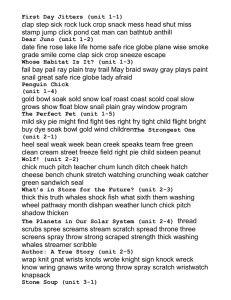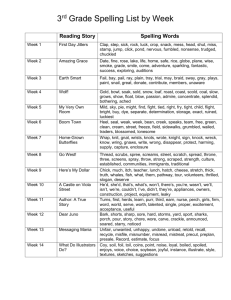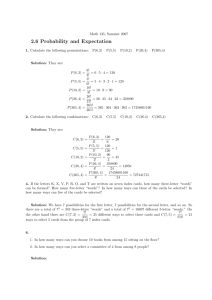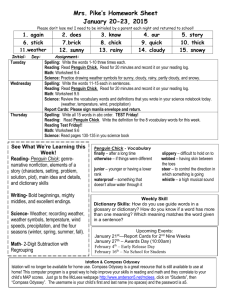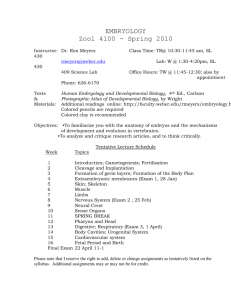MS Word
advertisement
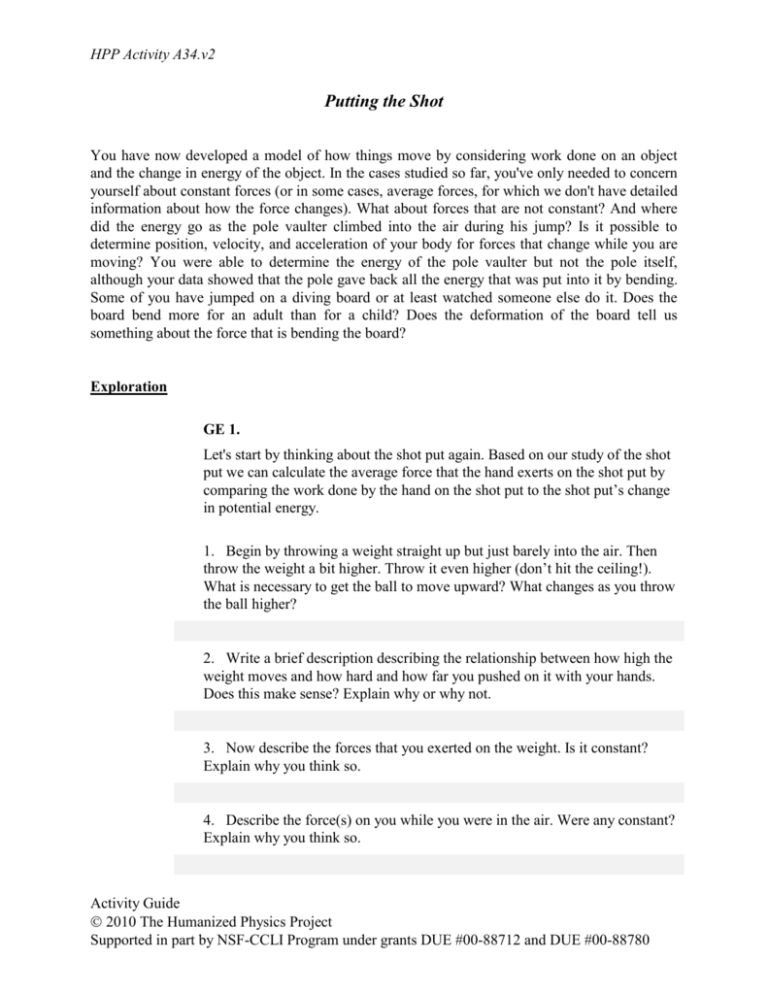
HPP Activity A34.v2 Putting the Shot You have now developed a model of how things move by considering work done on an object and the change in energy of the object. In the cases studied so far, you've only needed to concern yourself about constant forces (or in some cases, average forces, for which we don't have detailed information about how the force changes). What about forces that are not constant? And where did the energy go as the pole vaulter climbed into the air during his jump? Is it possible to determine position, velocity, and acceleration of your body for forces that change while you are moving? You were able to determine the energy of the pole vaulter but not the pole itself, although your data showed that the pole gave back all the energy that was put into it by bending. Some of you have jumped on a diving board or at least watched someone else do it. Does the board bend more for an adult than for a child? Does the deformation of the board tell us something about the force that is bending the board? Exploration GE 1. Let's start by thinking about the shot put again. Based on our study of the shot put we can calculate the average force that the hand exerts on the shot put by comparing the work done by the hand on the shot put to the shot put’s change in potential energy. 1. Begin by throwing a weight straight up but just barely into the air. Then throw the weight a bit higher. Throw it even higher (don’t hit the ceiling!). What is necessary to get the ball to move upward? What changes as you throw the ball higher? 2. Write a brief description describing the relationship between how high the weight moves and how hard and how far you pushed on it with your hands. Does this make sense? Explain why or why not. 3. Now describe the forces that you exerted on the weight. Is it constant? Explain why you think so. 4. Describe the force(s) on you while you were in the air. Were any constant? Explain why you think so. Activity Guide 2010 The Humanized Physics Project Supported in part by NSF-CCLI Program under grants DUE #00-88712 and DUE #00-88780 HPP Activity A34.v2 2 5. Describe the force(s) on the weight while you were catching it? Were any constant? Explain why you think so. 6. What did your hands do when catching the weight? Why do you think they did that? (Did the force they exerted do any work?) 7. How might we measure the forces while throwing the weight and catching it? Discuss this with your group and then with the entire class. If you throw something heavy into the air, do you notice anything about the forces exerted by your feet? Have your instructor set up the force plate and motion sensor. Make sure that the trigger rates for both are 50 Hz. Have a volunteer stand on the force plate and throw a weight upward while collecting force data and position data. Keep the knees straight during data collection – we want only your hand to do work. When you get a good (smooth) set of data answer the following questions. 7. Describe, in detail, the force as measured by the force plate. What force is it? Is it constant in time? Is it less than, equal to, or greater than the weight of the ball being thrown? 8. When did the toss begin? How can you tell? 9. When did the toss end (when did the force of the hand on the ball become zero)? How can you tell? 10. Estimate the average net force exerted on the ball just during the upward toss? (We will look at the catch later.) Think carefully how you might determine this value. What was the force when the toss began? What was the force when the toss ended? What was the maximum force during this part of the toss? 11. How far did the ball move upward during the toss? How much work was done on the ball by the hand during the toss upward? Activity Guide 2010 The Humanized Physics Project HPP Activity A34.v2 3 12. From the data, determine how high the ball moved after losing contact with the hand. 13. Compare the work done by the average force (from 10) on the ball, to the change in gravitational potential energy of the ball when it is at its highest point. Discuss any discrepancies. Invention GE 2. Notice that we have avoided the fact that the force is not constant by finding an average force to replace the more complicated real force during the toss. How might we use our understanding of work to properly find the work done by a non-constant force? Let's go back and look at the graphs generated in GE 1. First, have your instructor make a plot of Force versus position just for the part of the graph that corresponds to the upward toss. Let's look at that graph carefully. On the graph of F vs. x draw a horizontal line representing the average force on the ball. Also draw two vertical lines representing the beginning of the upward toss and the end of the upward toss (when the force on the ball drops to zero). You calculated the work done to be W=Faved. But the right hand side of this equation looks like calculating a length times a width! 1. Is there a rectangle in the picture that has this length and width? What do we call this quantity? We can therefore define the work done by a constant (or average) force, as the area under the curve of a Force versus position graph. W=area under a F vs. x graph What if we can't easily determine the average force on such a graph? Is there a way to find the area under an arbitrary shape on the graph? Scientists use a fairly straightforward technique to do this. Activity Guide 2010 The Humanized Physics Project HPP Activity A34.v2 4 2. How much work is done by the hand on the ball, from the first data point to the second? Look carefully at the shape of the graph. Imagine a small rectangle! Discuss your method for calculating this work with your instructor. 3. If we can estimate the work done during each interval with an area, then we should be able to add all the little rectangles to get a more accurate value for the total area. Do this and record your value in the space below. 4. Compare this new value for the work done with the value you got when you estimated the average force over the entire upward toss. 5. Now compare this better calculation for the work done to the change in potential energy. Is your new calculation in better agreement? Application GE 3. Now we know what to do when the force is not constant. We have looked at just such a force in an earlier module when we looked at the elastic properties of tendons and cartilage. And just as we have done in the past, we will try to model the tendons with a simpler system -- the jumping chick! Obtain a jumping chick from your instructor and set up an experiment to measure the force exerted by the spring as a function of the distance the spring stretches. You will want to start DataStudio and create an experiment with both a force probe and a motion sensor. Create a graph of force vs. position. Now comes the critical question. How can you simultaneously measure the force required to compress the chick's spring while measuring the change in length of the spring? Try the following and don't forget to tare (zero) your force sensor before starting! Motion sensor Force sensor Activity Guide 2010 The Humanized Physics Project HPP Activity A34.v2 5 Collect data for Force vs. squeeze distance of your chick. Transfer your data to Excel. You need to have your chick's position start at zero when the force is zero. Create a new column in Excel and in that new column, subtract the chick's starting position from all measurements. If you graph the force vs. this new column you should get a line with zero intercept. Fit your data to the best model and be sure to put the equation on the graph and set the intercept to zero. Paste your graph with the best-fit line and equation here. Don't quit Excel yet!!!!! Paste graph here… 1. Is the force required to compress the spring constant or does it vary in a consistent way? Explain how you arrived at your answer. Let's use our definition of work that we used above for a non-constant force. We will find the work done for very small changes in length for the spring for which the force is very nearly constant and we will add up all those little pieces of work to get the total. The process is illustrated in the figure below. Each little rectangle represents the work=Fnx (each Fn is the average force over each interval x) and if we add up all the little rectangles we get a triangle! F Fn x x 2. What is the area of a triangle in general? What specifically is the area of the triangle in the graph above where F and x are the length of the sides of the triangle? Activity Guide 2010 The Humanized Physics Project HPP Activity A34.v2 6 3. What is the equation of the best-fit line for the force vs. x data for a spring in general? This is Hooke's law. 4. Combine your answers in 2 and 3 to get an equation for the potential energy of a spring as a function of the compression (or stretch) of the spring. You can ask your instructor for help with this one! There are no numbers yet; we're just looking for a general mathematical formula. 5. What is the potential energy stored in your chick's spring when fully compressed? Now we're looking for some real numbers! Show how you got your answer and express your answer in Joules. 6. Now the spring force is a conservative force so all the work you do in compressing the spring is stored in the spring as potential energy. When the chick jumps all that energy is released into the chick as kinetic energy. And that energy is ultimately converted into gravitational potential energy. So, from your answer in 5, calculate the velocity that the chick should have just as it leaves the floor when jumping. Remember that energy is conserved! Show your calculation and answer in the space below. 7. If all the work you did in compressing the chick's spring is converted into spring potential energy and then into the chick's kinetic energy is finally turned into gravitational potential energy, how high should the chick jump? Show all work! 8. Now set up the motion detector so it can see the chick and graph position and velocity vs. time. Set the trigger rate for the motion detector to 30/second. Compare the actual maximum height and the maximum velocity of the chick to your prediction in 6 and 7. Discuss the accuracy of your prediction and possible sources of errors. 9. Finally, based on what you've just discovered, discuss the results of the human jumping that started this exercise. Why do your legs bend more when you fall from a higher height? Why do you go higher when you bend your legs more? Activity Guide 2010 The Humanized Physics Project HPP Activity A34.v2 7 Be prepared to discuss your results with the rest of the class and work some sample problems involving work and energy. Activity Guide 2010 The Humanized Physics Project


